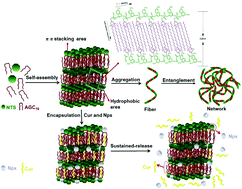当前位置:
X-MOL 学术
›
Soft Matter
›
论文详情
Our official English website, www.x-mol.net, welcomes your
feedback! (Note: you will need to create a separate account there.)
A multifunctional supramolecular hydrogel: preparation, properties and molecular assembly
Soft Matter ( IF 2.9 ) Pub Date : 2018-01-02 00:00:00 , DOI: 10.1039/c7sm02358h Lin Wang 1, 2, 3, 4, 5 , Xuefeng Shi 1, 2, 3, 4, 5 , Yaqian Wu 1, 2, 3, 4, 5 , Jian Zhang 6, 7, 8, 9 , Yuejun Zhu 6, 7, 8, 9 , Jinben Wang 1, 2, 3, 4, 5
Soft Matter ( IF 2.9 ) Pub Date : 2018-01-02 00:00:00 , DOI: 10.1039/c7sm02358h Lin Wang 1, 2, 3, 4, 5 , Xuefeng Shi 1, 2, 3, 4, 5 , Yaqian Wu 1, 2, 3, 4, 5 , Jian Zhang 6, 7, 8, 9 , Yuejun Zhu 6, 7, 8, 9 , Jinben Wang 1, 2, 3, 4, 5
Affiliation

|
A novel supramolecular hydrogel was designed and constructed by molecular self-assembly of a cationic gemini surfactant, 1,3-bis(N,N-dimethyl-N-cetylammonium)-2-propylacrylate dibromide (AGC16), and an anionic aromatic compound, trisodium 1,3,6-naphthalenetrisulfonate (NTS). Owing to its unique structure, the hydrogel (abbreviated as AGC16/NTS) has the potential to be used as a multifunctional drug delivery system. The structure and properties of AGC16/NTS were characterized by rheological measurements, differential scanning calorimetry, variable-temperature 1H nuclear magnetic resonance, ultraviolet-visible spectroscopy, variable-temperature fluorescence emission spectroscopy, cryogenic scanning electron microscopy, transmission electron microscopy and X-ray diffraction methods. The rheological and DSC analysis results revealed that the gel AGC16/NTS was formed below 57 °C. It was found from UV-vis, fluorescence and 1H NMR spectroscopy characterization that aromatic π–π stacking and hydrophobic forces were indispensable to the formation of AGC16/NTS. The Cryo-SEM and TEM observation results indicated that gelators AGC16 and NTS self-assembled into one-dimensional fibers which further tightly intertwined to form a three-dimensional network structure. Based on the spectroscopic data and X-ray diffraction measurement results, a self-assembly model was proposed, helping to further understand the molecular self-assembly mechanism of AGC16/NTS. It was also found that the electrostatic force, hydrophobic force and π–π interaction were the three main driving forces for the gelation. The multiple non-covalent interactions between AGC16 and NTS endowed the hydrogel with excellent performance when the hydrogel was used as a carrier for drug delivery, due to multiple micro-domains within the same gel system. We further investigated the encapsulation and releasing properties of the hydrogel, using the hydrophobic model drug curcumin (Cur) and the model drug naproxen sodium (Npx) with aromatic ring structure. The fluorescence spectroscopy analysis confirmed that Npx was carried through aromatic π–π stacking and the 1H NMR measurement result revealed that Cur was encapsulated within the hydrophobic cavities of AGC16/NTS through hydrophobic interaction. Moreover, the drug release study results showed a sustained release of drugs from the hydrogel, indicating good application prospects in exploring new multifunctional drug delivery systems.
中文翻译:

多功能超分子水凝胶:制备,性质和分子组装
通过阳离子双子表面活性剂,1,3-双(N,N-二甲基-N-乙酰胺基)-2-丙基丙烯酸二溴酯(AGC 16)和阴离子芳族化合物的分子自组装,设计和构建了一种新型的超分子水凝胶。,1,3,6-萘三磺酸三钠(NTS)。由于其独特的结构,水凝胶(缩写为AGC 16 / NTS)具有用作多功能药物输送系统的潜力。通过流变学测量,差示扫描量热法,可变温度1表征AGC 16 / NTS的结构和性能。H核磁共振,紫外可见光谱,可变温度荧光发射光谱,低温扫描电子显微镜,透射电子显微镜和X射线衍射方法。流变学和DSC分析结果表明,低于57℃形成凝胶AGC 16 / NTS。从紫外可见,荧光和1 H NMR光谱分析发现,芳族π-π堆积和疏水力对于AGC 16 / NTS的形成是必不可少的。Cryo-SEM和TEM观察结果表明,胶凝剂AGC 16NTS自组装成一维纤维,进一步紧密缠绕在一起,形成三维网络结构。基于光谱数据和X射线衍射测量结果,提出了一种自组装模型,有助于进一步理解AGC 16 / NTS的分子自组装机理。还发现静电力,疏水力和π-π相互作用是凝胶化的三个主要驱动力。AGC 16之间的多个非共价相互作用当水凝胶用作药物输送载体时,由于同一凝胶系统中有多个微区,NTS使水凝胶具有出色的性能。我们使用具有芳香环结构的疏水模型药物姜黄素(Cur)和模型药物萘普生钠(Npx),进一步研究了水凝胶的包封和释放特性。荧光光谱分析证实,Npx是通过芳族π-π堆积进行的,并且1 H NMR测量结果表明,Cur被封装在AGC 16的疏水腔内/ NTS通过疏水相互作用。此外,药物释放研究结果表明药物从水凝胶中持续释放,表明在探索新型多功能药物输送系统方面具有良好的应用前景。
更新日期:2018-01-02
中文翻译:

多功能超分子水凝胶:制备,性质和分子组装
通过阳离子双子表面活性剂,1,3-双(N,N-二甲基-N-乙酰胺基)-2-丙基丙烯酸二溴酯(AGC 16)和阴离子芳族化合物的分子自组装,设计和构建了一种新型的超分子水凝胶。,1,3,6-萘三磺酸三钠(NTS)。由于其独特的结构,水凝胶(缩写为AGC 16 / NTS)具有用作多功能药物输送系统的潜力。通过流变学测量,差示扫描量热法,可变温度1表征AGC 16 / NTS的结构和性能。H核磁共振,紫外可见光谱,可变温度荧光发射光谱,低温扫描电子显微镜,透射电子显微镜和X射线衍射方法。流变学和DSC分析结果表明,低于57℃形成凝胶AGC 16 / NTS。从紫外可见,荧光和1 H NMR光谱分析发现,芳族π-π堆积和疏水力对于AGC 16 / NTS的形成是必不可少的。Cryo-SEM和TEM观察结果表明,胶凝剂AGC 16NTS自组装成一维纤维,进一步紧密缠绕在一起,形成三维网络结构。基于光谱数据和X射线衍射测量结果,提出了一种自组装模型,有助于进一步理解AGC 16 / NTS的分子自组装机理。还发现静电力,疏水力和π-π相互作用是凝胶化的三个主要驱动力。AGC 16之间的多个非共价相互作用当水凝胶用作药物输送载体时,由于同一凝胶系统中有多个微区,NTS使水凝胶具有出色的性能。我们使用具有芳香环结构的疏水模型药物姜黄素(Cur)和模型药物萘普生钠(Npx),进一步研究了水凝胶的包封和释放特性。荧光光谱分析证实,Npx是通过芳族π-π堆积进行的,并且1 H NMR测量结果表明,Cur被封装在AGC 16的疏水腔内/ NTS通过疏水相互作用。此外,药物释放研究结果表明药物从水凝胶中持续释放,表明在探索新型多功能药物输送系统方面具有良好的应用前景。











































 京公网安备 11010802027423号
京公网安备 11010802027423号